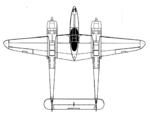Since my skills in M$ Paint are growing exponentially, here are some sqetches of good planes, re-engined with different engines.
P-38 with R-2600 (2 x 1600 HP feasible in 1941, 1750 year after that, 1900 HP in 1944) - perhaps the fastest piston job, plus suddenly the A-20, B-25, B-26, A-26, P-61, F-7F became redundant. Note that oil coolers are now where turbo is for plain P-38s located:
P-38 with R-2600 (2 x 1600 HP feasible in 1941, 1750 year after that, 1900 HP in 1944) - perhaps the fastest piston job, plus suddenly the A-20, B-25, B-26, A-26, P-61, F-7F became redundant. Note that oil coolers are now where turbo is for plain P-38s located:








